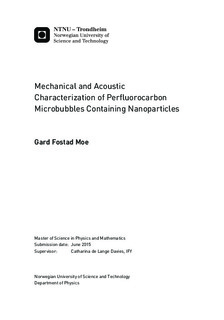Mechanical and Acoustic Characterization of Perfluorocarbon Microbubbles Containing Nanoparticles
Master thesis
Permanent lenke
http://hdl.handle.net/11250/2352170Utgivelsesdato
2015Metadata
Vis full innførselSamlinger
- Institutt for fysikk [2677]
Sammendrag
In order to optimize the production and behaviour of ultrasound contrast agents it is necessary to map their characteristics. The aim of this master's thesis is to investigate different batches of perfluoropropane microbubbles stabilized by polymer nanoparticles and protein through the use of atomic force microscopy and acoustic measurements. This provides insight into how the microbubble responds to acoustic fields and may aid in predicting in-vivo behaviour. By using four different models: Reissner theory, Hertz theory, elastic membrane theory and the de Jong model the Young's Modulus of the nanoparticle microbubbles was investigated. A linear relationship was established between the Young's Modulus and the microbubble diameter for the Hertz theory and the de Jong model in three out of five measurement series. Across all the experiments the range of the Young's Modulus was: 0.82-8.31 MPa with the Reissner theory, 0.29-47.06 MPa with the Hertz theory, 2.9-2395.3 MPa using the elastic membrane theory and 6.43-137.16 kPa for the De Jong model. By comparing the nanoparticle microbubbles to bubbles with a shell of bovine serum albumin and SonoVue\reg\ it was determined that the addition of nanoparticles lowers the Young's Modulus of the shell accoring to the Reissner and de Jong theory. Modelling the microbubble as a homogeneous sphere as per the Hertz theory, however, predicts an increase in the Young's Modulus compared to albumin and phospholipid microbubbles. By measuring the attenuation of the microbubbles at evenly spaced intervals over 18 minutes it was found that the primary factor causing attenuation loss for the perfluropropane microbubbles is the gas exchange process where perfluoropropane seeks out of the bubble core and air diffuses in. The shell was also found to have a stabilizing effect in this process, slowing the dissolution by obstructing gas flow. By producing the microbubbles with microfluidic systems it is possible to attain narrower size distributions than with the ultraturrax setup and this causes a narrower attenuation band across the frequency axis. Backscatter experiments performed with three different transducer pairs showed that microbubbles combined with nanoparticles can produce subharmonics and a wide range of harmonics and ultraharmonics at low mechanical indeces.
